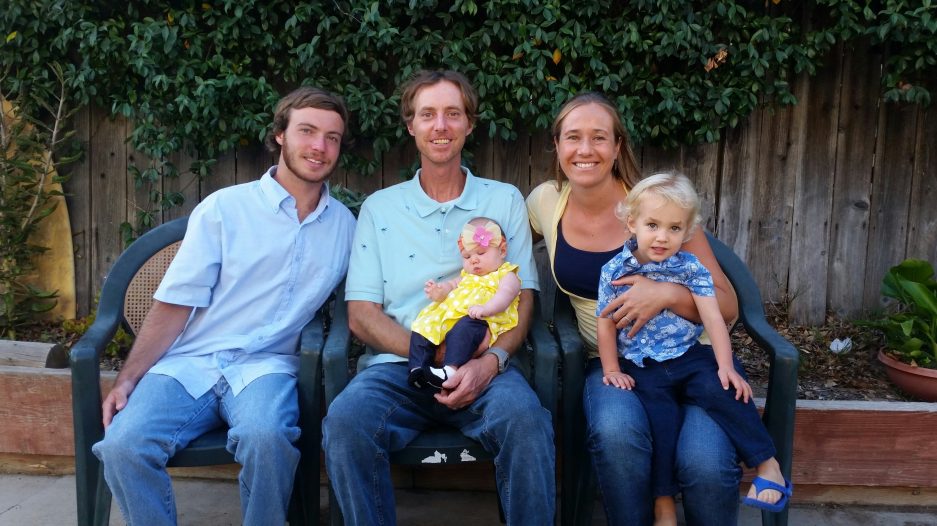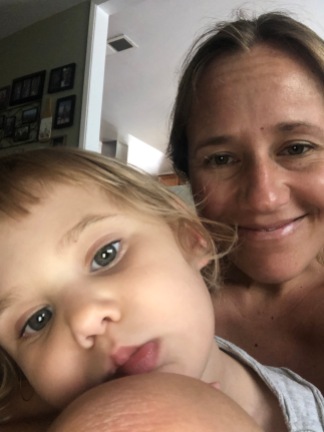“Who is my first grade teacher going to be?” Tate asks a few weeks ago.
“Mrs. Keswick,” I reply.
Tate looks at me oddly.
“That’s Mama!” I say with enthusiasm, trying to make it sound far more exciting than it actually is.
Tate laughs. I laugh, relieved that (at least for the moment) he seems okay with the idea of home school and having his mom as his teacher.
As the official first day of school finally arrives for many school districts, I watch as my Facebook feed fills with first day photos. In these photos kids are cutely posed in front of their open laptops. Most look to have their own desk or work area. Notebooks and pencils sit on the side of the computer. Some kids wear headphones.
The photos are cute, a representation of this strange new type of education- Distance Learning. The kids look happy in the pictures, but I am sad when I think about how quickly the Distance Learning “honeymoon” will probably fade for kids. Once this first day excitement starts to wean and kids are left with more time on the computer and no actual in-person interaction with teachers and peers, I believe happiness will also start to wean and instead will be replaced by boredom, loneliness, over stimulation and potentially depression.
I also see a lot of privilege in these photos—white privilege and able-bodied privilege. I am not saying these kids shouldn’t have all they do—nice computers, accessible printers, reliable internet connection, private and organized work space, all the materials they could need and educated parents who can not only troubleshoot technological issues but who can also provide the academic support that is paramount to success during distance learning. These kids speak English, understand directions and can sit in front of a computer to listen to a lesson. These kids could potentially have a tutor to assist with their learning, if needed. Academically, I don’t worry too much about these kids.
I worry about the kids who do not have these resources. I worry about the gap that will inevitably grow between those who have access to all of this and those from certain backgrounds who are more likely to not have access (children of color, children from lower SES backgrounds, children whose parents don’t speak English, children who are learning English themselves and children from abusive homes).
I also worry about the kids with special needs— the kids who possibly don’t have a cute picture in front of their computer on the first day because the virtual classroom is confusing and potentially overwhelming. Maybe they don’t understand what is being said from a receptive language standpoint. Maybe they can’t see the visuals presented in front of the camera. Or maybe they need to touch and feel something to make the learning connection. Maybe the Zoom commotion with teacher, students and aides is too much for them to process. Maybe the voice coming from the computer leads them to a sensory meltdown. Maybe they can’t physically sit in a chair, at a desk and look at a computer. Maybe these kids are not meant to learn in a virtual world because their gifts are ones that take face-to-face connection to be evident.
I wish I had taken Coral’s picture on her first Zoom meeting. She was lying on the floor, licking her toy. She didn’t wave hello when her teacher said, “Hi, Coral!”, even though she knows how to wave hello to people (who are actually present). She didn’t acknowledge any of the kids or aides, even though she does acknowledge people everyday with eye contact, smiles and touch. She wasn’t able to participate verbally because she doesn’t talk with words. She takes someone’s hand and takes them to what she wants (the pantry for snack, the high chair for a meal, the back door to play in the pool, a toy for help or to play). She also uses a picture exchange system to communicate, an impossible task to implement virtually for Coral. She didn’t get to practice being in the proximity of her classmates, doing parallel play.
Beyond all of this, the teacher’s connection kept cutting out. The audio was spotty. It was actually hard for me to follow at times.
How can Coral be expected to learn anything in this odd virtual classroom?
THESE are the kids I worry about.
Most parents (and by that I mean 99.9% of parents) don’t have a child with as significant of special needs as Coral. It’s easy for her to be forgotten, for people to choose pity over empathy. It’s easy for people to think Distance Learning “isn’t so bad” because it works fairly well for their typically developing child. It’s easy for some parents of typically developing kids to think, “It’s only a year. My kid can catch up next year.” It’s easy for us all to forget that we need equity and not equality- for our most at-risk kids to have a chance to be back safely in the classroom FIRST and engaged in face-to-face learning.
I also believe it’s easy for some people to choose fear over thoughtful analysis of data. It’s an uneasy and anxious time, making it easier to make decisions out of fear. One thing Coral has taught me is to not make decisions out of fear. We have made countless decisions for her health and well-being. Some decisions could have meant life or death: Do we stay in the hospital on oxygen or go home on hospice care? I have learned not to decide out of fear but to instead weigh the options, analyze the data and to move forward without hesitation (or regret) with a decision. Some decisions have been hard and some have required a leap of faith. Everyday I could live in fear with Coral: Will seizures return? Will she die in her sleep, like other kids with her diagnosis? Will I be able to care for her for years to come? But I don’t. I can’t live that way because it would be a joyless existence.
From what I have seen on my social media and in the news, talk about reopening the schools (in any form- hybrid or traditional) is muddied with fear, diluted with memes that don’t use facts but instead feed stubborn opinions, and embedded in a political narrative. Reopening schools has somehow become another part of “us versus them,” where open dialogue seems all but impossible.
This is a major problem for Coral and for all kids that need to be at school for at least some of the week to access their essential services (physical, occupational, and speech therapy). This is a major problem for a child, like Coral, who takes thousands of times to learn something, yet only a short time to lose the very skill she worked so hard to gain. This period of critical brain development (the “First 5 Years” as it is often referred to) is fleeting for Coral. At four years old, this year is meant to be her second year in her special education preschool class. As of right now, she has received 2/3 of a year of preschool (last August through March). Compensatory services that may be offered down the road by the school district (to make-up for lost services now) will never return to us this critical time of development.
We are starting to get a better understanding of the COVID-19 virus- how it is passed, preventive measures we can all take to slow the spread, best practices in hospitals to care for patients, the populations that have the highest risk of developing severe complications, and the extremely low death rate among children (one child has died in California) compared to a higher death rate among other populations. What we do not have the ability to quantify at the moment is the extreme effect on our children with disabilities (and all children for that matter, especially those who are marginalized and our youngest learners) for lack of in-person school. For years to come, we will be picking up the pieces of a generation of kids that lost critical learning time. The WHO describes health as “ …a state of complete physical, mental and social well-being and not merely the absence of disease or infirmity.” For our kids’ well-being, we have to have an honest conversation about health as multifaceted versus only the absence of Covid-19.
Our country’s history of education for those with disabilities is long, wrought with stereotyping, full of segregation and has evolved towards more inclusive practices as a result of parent and educator advocacy, as well as advocacy by those with disabilities themselves. Those with disabilities were excluded since the beginning of the public education system, often being placed in institutions. They are the only minority group that are still (in the year 2020) segregated into different classrooms. Yes, there are options for inclusion, but they are often limited for those with the greatest needs. And even inclusion can feel not very inclusive when it is not done well with the very best educators and supports. It has taken years of advocacy to get where we are in the education system for kids with special needs through the entitlement of FAPE (free appropriate public education), guaranteed by the Rehabilitation Act of 1973. Distance Learning is not appropriate for Coral, given that she is nonverbal and has an intellectual disability. In ways, it feels like she has (again) been forgotten.
For Coral, this year is not about making lemonade out of lemons with some cute photos in front of a computer. Sure, I try to stay positive on a daily basis. But I refuse to resign myself to accepting what the school district will or will not do. Instead, I will be Coral’s voice. I will always advocate for what I believe is best for her because I am not convinced that school districts are thinking about Coral’s unique needs. I am not convinced that public schools and their teacher unions are exploring every option to get my Coral fish back onto campus. Private preschools have been safely operating in our area for months and camps have been up and running for almost 3 months, without incident. As a county we have met the metrics to be removed from the watch list and thus should be able to open all schools with safety measure in place in one week from now (if the good data persists). However, I do not believe that Coral’s public preschool has a solid plan or even a true desire to reopen. I have to wonder how much of this has to do with politics, negotiations with labor associations and liability concerns, instead of the actual Covid-19 virus.
I have to hope that other parents and teachers will join me in advocating for a return to at least some in-person instruction for our children with extraordinary needs. I have to hope that the school districts will receive more funding and will then apply that funding with true flexibility, innovation and creativity to find a solution that will work for Coral and other children to receive the education they deserve and need in a safe way— to receive their free appropriate public education.
I have to hope. But more importantly, I have to advocate.
And I will always do that for my Coral fish.




